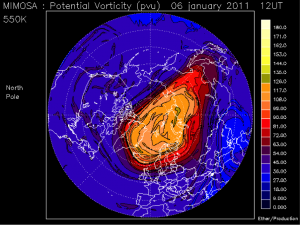Polar vortex
During the Arctic in winter (polar night), the stratosphere – in addition to its air mass not being able to mix vertically – can become caught in a vortex, which will prevent the air in the stratosphere from mixing with neighbouring air masses. This results in the creation of a vortex, called the Arctic polar vortex.
The force of this vortex is measured in potential vorticity. The higher the potential vorticity, the stronger the polar vortex and the higher the velocity around ithe centre of the vortex.
A polar vortex also appears over Antarctica. The difference between the Arctic polar vortex and the Antarctic polar vortex is that the Antarctic vortex is always fixed over the Antarctic continent, centred above the South Pole. The Arctic polar vortex, on the other hand, tends to be attracted to land that surrounds the Arctic Ocean and is therefore more prone to deform. While an Antarctic polar vortex can increase in intensity and can become very strong, the tendency for an Arctic polar vortex to deform makes it possible for them to dissipate more easily.
The figure caption a polar vortex observed on January 6, 2011 over the Arctic at an altitude of about 23 km. The air masses close to its exterior circulate at nearly 200 km / h and can cross the Earth in only 3 – 4 days.



 This project (EDU-ARCTIC) has received funding from the European Union’s Horizon 2020 research and innovation programme under grant agreement No 710240. The content of the website is the sole responsibility of the Consortium and it does not represent the opinion of the European Commission, and the Commission is not responsible for any use that might be made of information contained.
This project (EDU-ARCTIC) has received funding from the European Union’s Horizon 2020 research and innovation programme under grant agreement No 710240. The content of the website is the sole responsibility of the Consortium and it does not represent the opinion of the European Commission, and the Commission is not responsible for any use that might be made of information contained.